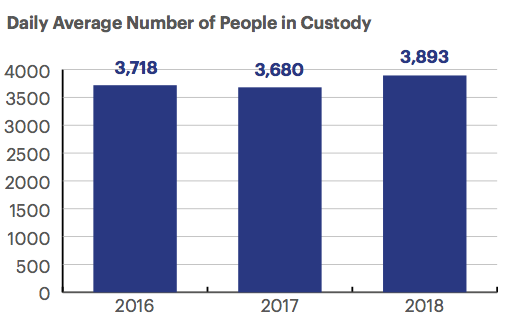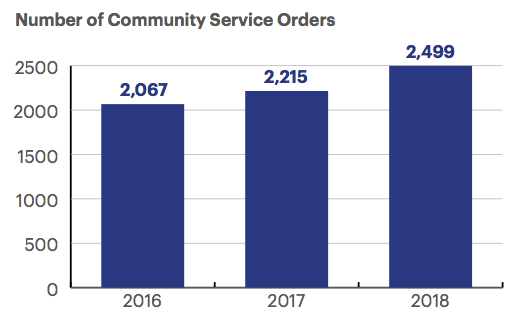2: Imprisonment as a last resort (2019)
Standard 2:
Imprisonment is used as a last resort. This principle is enshrined in domestic legislation, with focus on the promotion and proportionate use of alternatives to custody.
Rationale:
One of IPRT’s core guiding principles is ‘imprisonment as a last resort’. The damaging impact of imprisonment on the individual, as well as its ripple effects on families and communities, is enormous.[102] Separation from family can lead to a breakdown in relationships, while the experience of imprisonment itself can result in institutionalisation, which can have profound damaging effects on the individual. Imprisonment can also act as a barrier to employment upon release, as well as a significant barrier in accessing other supports such as housing. Community sanctions, by contrast, can motivate and provide individuals with a sense of purpose by participating in and making a contribution to society, while also allowing those who have caused harm to ‘pay back’ or make reparation directly to the community.
Current context:
As of 1 July 2019, Ireland’s imprisonment rate is 82 per 100,000,[103] and is ranked 39th out of 56 European countries. Nordic countries ranked near the lowest: Iceland at 37 per 100,000, Finland at 51 per 100,000 and Sweden at 59 per 100,000.[104]
Ireland saw an 8% increase in the number of prisoners in custody between 1 January 2018 (3,631) and 31 December 2018 (3,911).[105] The numbers in custody exceeded 4,000 on 26 occasions in 2018.[106] In May 2019, the Minister acknowledged the increase in prison numbers:
I regret the reversal of the trend towards lower prisoner numbers...[107]
There were significant increases in those committed for sentences of less than 12 months (excluding fines committals).[108]
- Numbers committed under sentences of less than three months increased by 34.3% (the largest percentage increase of committals under sentence).
- Numbers committed under sentence of three to less than six months increased by 15.1%.
- Numbers committed under sentence of six to less than 12 months increased by 12.6%.
Council of Europe (CoE) Annual Penal Statistics also show Ireland’s high turnover ratio of prisoners, at 71.4% in 2017 compared to a European average of 45.8%.[109]
One welcome reduction has been in the number of committals for default of court-ordered fines, from 2,261 in 2017 to 455 in 2018 – a 79.8% decrease.[110] This significant drop has largely been a result of the implementation, since 2016, of the Fines (Payment and Recovery) Act 2014.[111]
In 2018, there was also a 12.8% increase in the number of community service orders handed down on 2017. However, the number of people accessing structured early release programmes, such as Community Return,[112] has declined from 455[113] in 2014 to 221[114] in 2017, dropping slightly to 218[115] in 2018. A Joint Strategy Steering Committee consisting of representatives of the IPS and the Probation Service examined the decline in numbers and concluded that reasons for this related to: unacceptable risk relating to feuding gangs; lack of willingness to change behaviour and engagement with services; and the increasing number of prisoners who had no stable address to which to return.[116] Revised practices are to be announced by the Minister for Justice and Equality.
According to Care After Prison 2018 statistics,[117] there has been an 86% completion rate for the Community Support Scheme (set up to support the early release of prisoners serving sentences of three to 12 months).
Indicators for Standard:
Indicators for Standard 2
Indicator S2.1: Principle of Imprisonment as a last resort enshrined in domestic legislation (new)
The principle of imprisonment as a last resort has not been enshrined in legislation, despite it being a recommendation made by the Penal Policy Review Group in 2014.[118]
Indicator S2.2: Committals under sentence (less than 12 months, excluding fines) (new)
Despite the introduction of legislation that requires judges to consider an alternative to a sentence of imprisonment for less than 12 months,[119] the table below shows an increase in the number of committals under sentence of less than 12 months by 21.3% between 2016 and 2018.[120]
| Year |
Committals under sentence (less than 12 months excluding fines) |
| 2016 |
2,557 |
| 2017 |
2,639 |
| 2018 |
3,104 |
Indicator S2.3: Daily average number of prisoners in custody
The chart below highlights the daily average number of persons in custody in Ireland. It shows an increase by 5.8% from 3,680 in 2017 to 3,893 in 2018.[121]

Indicator S2.4: Use of alternatives to custody as a substitute for short-term prison sentences
While statistics show an increase in the use of imprisonment, there was also an increase in the number of community service orders (CSO) handed out, which rose by 12.8% from 2,215 in 2017 to 2,499 in 2018.[122]

Analysis – Standard 2
There continues to be an over-reliance on imprisonment for persons convicted of less serious offences, despite its damaging social and economic impact on individuals, families and communities. Of particular concern is the significant increase in the number of committals under sentence for less than 12 months (excluding fines) in 2018.
In-depth research on sentencing and judicial attitudes is required in order to make sense of these trends. Further analysis is needed to ascertain whether CSOs are being used as a direct alternative to short-term prison sentences or whether the increase in the use of CSOs in 2018 relates to the impact of the commencement of the Fines (Payment and Recovery) Act.[123] In any case, while there was an increase in the use of CSOs in 2018, these numbers are still lower than peaks in 2011 and 2012 at 2,738 and 2,569 respectively.[124]
Daily prisoner numbers are also impacted by the increasing number of prisoners serving long sentences. The number of prisoners committed on sentences of five to 10 years increased by 9.6% from 2017 to 2018.[125] The numbers committed on sentences of 10 year plus increased by 22.2%. Although the number committed for a life sentence showed a decrease of 4.5% from 2017 to 2018, this cohort has grown steadily. In 2001, there were 139 people serving a life sentence in custody; at that time the average number of years served by a life-sentenced prisoner before release was 15.[126] In 2018 the average number of years served by a life sentenced prisoners was 17.5 years and as of the 31st of January 2019, there were 348 life sentenced prisoners in custody.[127]
As can be seen through the large reduction (79.8% decrease) in the number of committals for default of court-ordered fines, from 2,261 in 2017 to 455 in 2018, legislation can have a profound impact on prison population numbers and can drive the population upward or downwards. Therefore, impact assessment of all proposed legislation is required in order to avoid sentence inflation and expansion of the prison population.
Status of Standard 2: Regress
Progressive Practice:
Extension of presumption of short sentences in Scotland
Under Scottish legislation, a court must not pass a sentence of three months or less unless it considers that no other method of dealing with the person is appropriate.[128] In June 2019, the Scottish Parliament approved the Presumption Against Short Periods of Imprisonment Order,[129] which extends the presumption against short sentences from three months or less to 12 months or less.
In Ireland, the Criminal Justice (Community Service) Amendment Act 2011[130] sets out that if a court is of the opinion that an appropriate sentence for the convicted offence is less than 12 months, then the court shall consider making a CSO as an alternative to that sentence.[131] However, the language set out under Scottish legislation is stronger than in our domestic legislation. In Scotland:
- A court must not pass a sentence of imprisonment for a term of three months or less unless the court considers that no other method of dealing with the person is appropriate; and
- If a court passes a custodial sentence, judges must state the reason for their opinion on why no other method is appropriate in dealing with the person and have those reasons entered in the record of the proceedings.[132]
The above requirement is not legislated for in Ireland, despite a recommendation made by the Penal Policy Review Group (2014):
The Review Group recommends that, in all cases where a custodial sentence is imposed by a court, the court should set out its reasons in writing for so doing. The Group further recommends that this requirement be incorporated in statute.[133]
Sentencing developments in Ireland
IPRT welcomes that the Law Reform Commission will examine structured sentencing in its Fifth Programme of Law Reform.[134] [135] The project will examine to what extent general principles of sentencing combined with a suitable sentencing database could provide for a more structured sentencing system.
Other developments in this area include the Judicial Council Act 2019.[136] This includes provision for the establishment of a Sentencing Guidelines and Information Committee. The functions of the Committee will be to:
- prepare and present draft sentencing guidelines;
- make amendments to guidelines adopted by the Judicial Council;
- monitor the operation of guidelines;
- collate information on sentences imposed by the courts; and
- disseminate information to judges.[137]
The Committee may also conduct research on sentences imposed by the courts.[138] In addition, the Bill includes the establishment of a Judicial Studies Committee, to facilitate the continuing education and training of judges.[139]
Actions required:
| Action 2.1: |
A high-level group should be established by the Department of Justice and Equality to take a shared responsibility in identifying solutions and assigning actions to address the issue of overcrowding in Irish prisons. Representation should comprise legislators, the judiciary, the IPS, the Probation Service, community-based organisations and other government departments, including the Department of Health and the Department of Housing, Planning and Local Government. |
|---|
| Action 2.2: |
The Law Reform Commission should prioritise its examination of a structured sentencing system, with the inclusion of sentencing principles, in its programme of work for 2020. |
|---|
| Action 2.3: |
The Courts Service should collate and publish data on the use of sentencing across courts in a systematic manner. |
|---|
| Action 2.4: |
Legislators should implement their own recommendations including commuting sentences of less than six months for non-violent offences to CSOs. |
|---|
| Action 2.5: |
Impact assessment of all proposed legislation must be conducted. |
|---|
References:
-
102.
^
-
103.
^
-
104.
^
-
105.
^
-
106.
^
-
107.
^
-
108.
^
-
109.
^
-
110.
^
-
111.
^
-
112.
^
-
113.
^
-
114.
^
-
115.
^
-
116.
^
-
117.
^
-
118.
^
-
119.
^
-
120.
^
-
121.
^
-
122.
^
-
123.
^
-
124.
^
-
125.
^
IPS (2019) Annual Report 2018, p.25
-
126.
^
Griffin D. (2018), Killing Time, Life Imprisonment and Parole in Ireland, p.5, Palgrave MacMillan.
-
127.
^
-
128.
^
-
129.
^
-
130.
^
-
131.
^
See Section 3(a) (1) (a) of the Act.
-
132.
^
-
133.
^
-
134.
^
-
135.
^
-
136.
^
-
137.
^
-
138.
^
-
139.
^



